Pipelines fall into three main categories: floating pipelines, submerged or “sinker” lines and land or “shore” lines.
Floating pipelines
Floating pipelines are either formed of steel pipes supported at regular intervals by buoyancy units or surrounded by a buoyant case, or they are composed of pipes made of a buoyant material.
In all these cases the pipeline must be built to be flexible enough to endure the movement of the sea and currents. The pipe itself may be made flexible by inserting ball joints in the line at regular intervals or by adding lengths of flexible pressure hose. All floating pipelines are made in a modular fashion and are connected together by bolts or quick coupling devices.
Submerged or sinker pipelines
Submerged pipelines are made by welding a number of pipes together into a long string. They are floated into place, full of air and then sunk in the desired location (thus ‘sinkers’) by flooding the pipe. At each end of the pipeline, flanged connections or ball-joints are provided to enable the submerged lines to be connected to the floating or landlines.
Land or shore lines
Land or shore lines are relatively short lengths of standard pipe, bolted together laying onshore. Various devices are incorporated in the land pipeline so it can be moved or extended or to switch the flow to different sections of the discharge area. The line may also be equipped with manual or hydraulically operated valves, Y-pieces and bends of different angles.
All pipelines need to be turned regularly during use, to ensure that wear is even and hence pipeline life is maximised.
Subjects
Equipment
-
 Auger dredgers
Auger dredgers
-
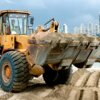 Auxiliary Equipment
Auxiliary Equipment
-
 Backhoe Dredgers
Backhoe Dredgers
-
 Barges
Barges
-
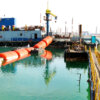 Booster Stations
Booster Stations
-
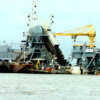 Bucket-Ladder Dredgers
Bucket-Ladder Dredgers
-
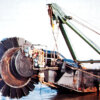 Bucket-Wheel Dredgers
Bucket-Wheel Dredgers
-
 Cutter Suction Dredgers
Cutter Suction Dredgers
-
 Dipper Dredgers
Dipper Dredgers
-
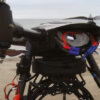 Drones
Drones
-
 Dustpan Dredgers
Dustpan Dredgers
-
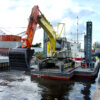 Environmental Equipment
Environmental Equipment
-
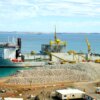 Fall Pipe Vessels
Fall Pipe Vessels
-
 Grab or Clamshell Dredgers
Grab or Clamshell Dredgers
-
 Other High-Tech Dredging Equipment
Other High-Tech Dredging Equipment
-
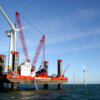 Jack-up Pontoons
Jack-up Pontoons
-
 Pipelines
Pipelines
-
 Ploughs, Beams and Rakes
Ploughs, Beams and Rakes
-
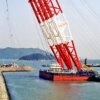 Pontoons
Pontoons
-
 Side Stone-Dumping Vessels
Side Stone-Dumping Vessels
-
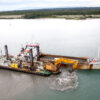 Split-Hull Hopper Dredgers
Split-Hull Hopper Dredgers
-
 Suction Dredgers
Suction Dredgers
-
 Trailing Suction Hopper Dredgers
Trailing Suction Hopper Dredgers
-
 Tugs and Tows
Tugs and Tows
-
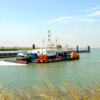 Water Injection Dredgers
Water Injection Dredgers
related
Articles
Pipeline design – density wave amplification and slurry dynamics

The effect of density waves and slurry dynamics on slurry pipeline flow assurance cannot be predicted with current slurry pipeline design methods. Current methods are based on steady-state assumptions, assuming that the mixture velocity and density are constant in time and in the pipeline. Therefore, using current design methods a dynamically stable pipeline cannot be guaranteed. Furthermore, new experiments in vertical pipelines show that density wave amplification is possible at mixture velocities far above the critical velocity. This article presents a new temporal design method based on 1D Driftflux CFD, which is able to model growing density waves.
DOWNLOAD
PDF Document | 631,16 KB
DOWNLOAD
PDF Document | 5,39 MB
DOWNLOAD
PDF Document | 2,49 MB
DOWNLOAD
PDF Document | 381,65 KB
DOWNLOAD
PDF Document | 662,82 KB
DOWNLOAD
PDF Document | 494,81 KB
DOWNLOAD
PDF Document | 168,74 KB
Numerical Simulation of the Development of Density Waves in a Long Pipeline and the Dynamic System B
DOWNLOAD
PDF Document | 208,49 KB
DOWNLOAD
PDF Document | 201,86 KB
DOWNLOAD
PDF Document | 236,2 KB
Cement and Soft Mud Mixing Technique Using Compressed Air-Mixture Pipeline: Efficient Solidification
DOWNLOAD
PDF Document | 306,17 KB
DOWNLOAD
PDF Document | 222,46 KB
DOWNLOAD
PDF Document | 261,75 KB
DOWNLOAD
PDF Document | 775,61 KB
News
Floating pipelines are either formed of steel pipes supported at regular intervals by buoyancy units or surrounded by a buoyant case, or they are composed of pipes made of a buoyant material.
In all these cases the pipeline must be built to be flexible enough to endure the movement of the sea and currents. The pipe itself may be made flexible by inserting ball joints in the line at regular intervals or by adding lengths of flexible pressure hose. All floating pipelines are made in a modular fashion and are connected together by bolts or quick coupling devices.
Submerged or sinker pipelines
Submerged pipelines are made by welding a number of pipes together into a long string. They are floated into place, full of air and then sunk in the desired location (thus ‘sinkers’) by flooding the pipe. At each end of the pipeline, flanged connections or ball-joints are provided to enable the submerged lines to be connected to the floating or landlines.
Land or shore lines
Land or shore lines are relatively short lengths of standard pipe, bolted together laying onshore. Various devices are incorporated in the land pipeline so it can be moved or extended or to switch the flow to different sections of the discharge area. The line may also be equipped with manual or hydraulically operated valves, Y-pieces and bends of different angles.
All pipelines need to be turned regularly during use, to ensure that wear is even and hence pipeline life is maximised.
Subjects
Equipment
-
 Auger dredgers
Auger dredgers
-
 Auxiliary Equipment
Auxiliary Equipment
-
 Backhoe Dredgers
Backhoe Dredgers
-
 Barges
Barges
-
 Booster Stations
Booster Stations
-
 Bucket-Ladder Dredgers
Bucket-Ladder Dredgers
-
 Bucket-Wheel Dredgers
Bucket-Wheel Dredgers
-
 Cutter Suction Dredgers
Cutter Suction Dredgers
-
 Dipper Dredgers
Dipper Dredgers
-
 Drones
Drones
-
 Dustpan Dredgers
Dustpan Dredgers
-
 Environmental Equipment
Environmental Equipment
-
 Fall Pipe Vessels
Fall Pipe Vessels
-
 Grab or Clamshell Dredgers
Grab or Clamshell Dredgers
-
 Other High-Tech Dredging Equipment
Other High-Tech Dredging Equipment
-
 Jack-up Pontoons
Jack-up Pontoons
-
 Pipelines
Pipelines
-
 Ploughs, Beams and Rakes
Ploughs, Beams and Rakes
-
 Pontoons
Pontoons
-
 Side Stone-Dumping Vessels
Side Stone-Dumping Vessels
-
 Split-Hull Hopper Dredgers
Split-Hull Hopper Dredgers
-
 Suction Dredgers
Suction Dredgers
-
 Trailing Suction Hopper Dredgers
Trailing Suction Hopper Dredgers
-
 Tugs and Tows
Tugs and Tows
-
 Water Injection Dredgers
Water Injection Dredgers
related
Articles
Pipeline design – density wave amplification and slurry dynamics

The effect of density waves and slurry dynamics on slurry pipeline flow assurance cannot be predicted with current slurry pipeline design methods. Current methods are based on steady-state assumptions, assuming that the mixture velocity and density are constant in time and in the pipeline. Therefore, using current design methods a dynamically stable pipeline cannot be guaranteed. Furthermore, new experiments in vertical pipelines show that density wave amplification is possible at mixture velocities far above the critical velocity. This article presents a new temporal design method based on 1D Driftflux CFD, which is able to model growing density waves.





















